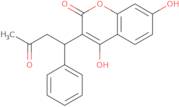Informations sur le produit
- 4,7-Dihydroxy-3-(3-oxo-1-phenylbutyl)-2H-1-benzopyran-2-one3-(a-Acetonylbenzyl)-4,7-dihydroxycoumarin
- 2,7-dihydroxy-3-(3-oxo-1-phenylbutyl)-4H-chromen-4-one
- 2H-1-Benzopyran-2-one, 4,7-dihydroxy-3-(3-oxo-1-phenylbutyl)-
- 3-(Alpha-Acetonylbenzyl)-4,7-Dihydroxycoumarin
- 3-(Α-Acetonylbenzyl)-4,7-Dihydrocoumarin
- 3-(α-Acetonylbenzyl)-4,7-dihydrocoumarin, 4-7-Dihydroxy-3-(3-oxo-1-phenylbutyl)-2H-1-benzopyran-2-one
- 4,7-Dihydroxy-3-(3-oxo-1-phenylbutyl)-2H-1-benzopyran-2-one
- 4-7-Dihydroxy-3-(3-Oxo-1-Phenylbutyl)-2H-1-Benzopyran-2-One
- Coumarin, 3-(α-acetonylbenzyl)-4,7-dihydroxy-
- Triethyloxonium Hexafluorophosphate
- Voir d'autres synonymes
- 7-Hydroxywarfarin
Warfarin is a drug that inhibits the synthesis of vitamin K-dependent clotting factors, thereby prolonging the time it takes for blood to clot. Warfarin is used as an anticoagulant in the prevention and treatment of deep vein thrombosis, pulmonary embolism, and other conditions. It is also used to treat or prevent hiv-associated thrombocytopenia. The effects of warfarin are dose-dependent and can be monitored by measuring the prothrombin time (PT) and international normalized ratio (INR). Warfarin has been shown to interact with a number of drugs including carbamazepine, which may lead to increased risk of bleeding. Warfarin also interferes with the activity of some drugs such as statins by inhibiting their ability to transport cholesterol from peripheral tissues into liver cells. This results in decreased cholesterol levels in blood plasma and a decreased rate of synthesis of low density lipoprotein (





